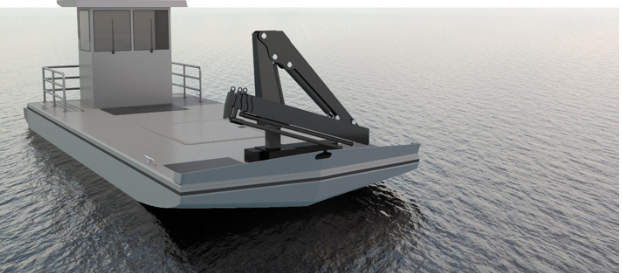DLBA Naval Architects, a division of Gibbs & Cox Inc., have developed an aquaculture support vessel (ASV).
DLBA said that industry research indicates that most aquaculture support vessels are typically skiffs, barges, and makeshift rafts which serve the purpose, but don’t lend themselves to improved productivity. In developing the ASV design DLBA conducted site visits to aquaculture farms to assess operations and understand farm owner needs.
The ASV was developed to achieve flexibility. In doing so, the hull form will provide a stable platform for hoisting and managing oyster pots, sorting tables, wash tumblers, and other associated equipment. The design incorporates a 2,500-lb. capacity knuckle boom crane on the foredeck, and a hydraulic power pack and high capacity (3") sea water pump in an internal compartment below deck. The hydraulic power pack and seawater pump are configured with quick change fittings for flexibility and ease of service or replacement.
The vessel’s deck has been kept flush and as clean as possible to minimize tripping hazards. The small but functional pilothouse provides good visibility and protection from the elements when navigating during inclement weather. Most importantly, the vessel meets USCG stability requirements when lifting loads up to 2,500 lbs. In order to provide this capability, which is not available on other vessels of this size, is the below deck ballast tank for use during heavy lifting operations.
The 12' beam with 3/8" thick deck plate (5083 alloy) allows for a clean, strong work surface to accommodate a variety of equipment normally stored on shore. The onboard knuckle boom crane allows for loading and unloading of deck equipment to suit daily operations. Additionally, the high crane capacity and ballast tank provided will allow this vessel to safely move pot anchors up to 2,500 lbs.
Once the mission is complete, the ballast water is pumped out, and the vessel is capable of getting on plane to the next worksite. The integral sea water system with quick connects will make it easier for supporting farming operations and keeping the deck clean. The simple integrated features and large capacity of this platform will allow for a reduction from the typical three-person crew to a two-person crew reducing some overhead and improving bottom line results.
The design targets using OXE 150-hp diesel outboard engines. The OXE diesel outboards were selected since they meet EPA Tier 3 emission standards and can reduce fuel consumption by up to 30%. Life to overhaul versus gas outboards can improve from 1,000 hours to 5,000 hours. A gasoline variant is available for those customers who prefer it.
The vessel’s scantlings are designed to meet the requirements of the 2019 ISO 12215 rules for a Category C Workboat. The hull will be built using 5083 aluminum alloy for strength and corrosion resistance. The detailed structural design is engineered to be production friendly by exploiting the use of CNC cut profiled parts.




